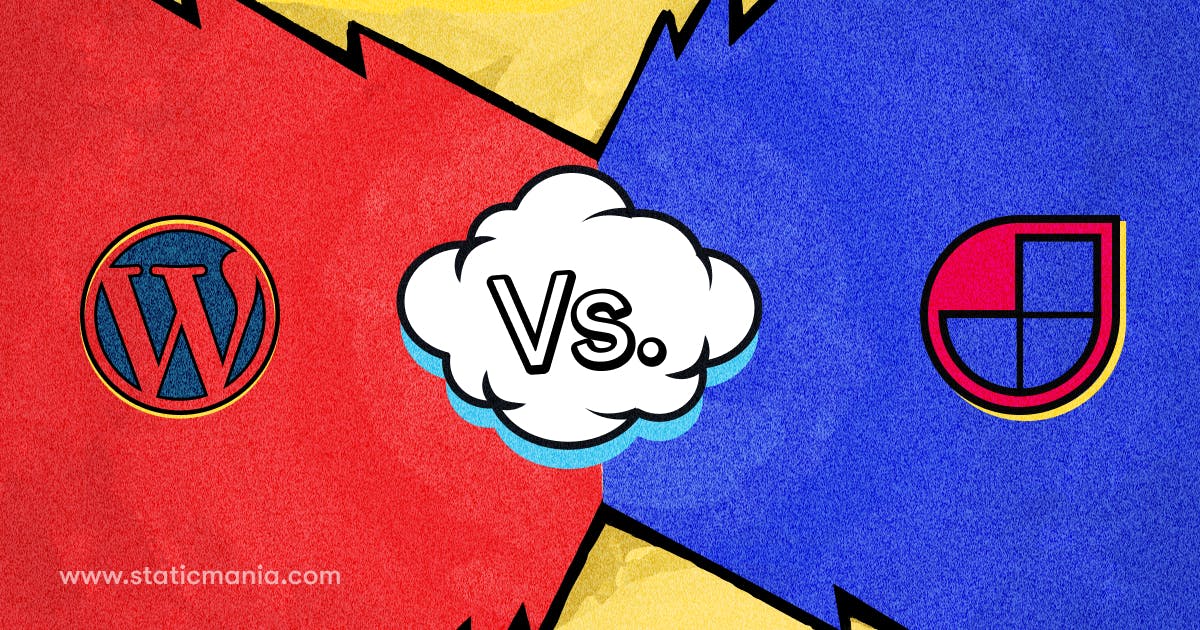July 20, 2022
JAMstack VS WordPress: Which is On Track?

Nusrat Sarmin

When you are thinking about building your dream website, choosing the right tech stack impacts performance, security, and long-term maintenance. WordPress powers over 43.5% of all websites as of April 2025 (W3Techs) *1, making it the most widely used CMS globally. In contrast, Jamstack is rapidly gaining adoption, especially among developers prioritising speed and scalability—81% of developers using Jamstack report better performance (Netlify, 2023).
With increasing demand for faster load times, stronger security, and lower server costs, the debate between Jamstack Vs WordPress has become more relevant than ever. This article breaks down the key differences to help you choose what best fits your needs.
To get the answer, let's dive in...
An Overview
We understand you're looking for a web development agency. When you are going to develop your dream project, one of the first questions is: Should my website be built with WordPress or Jamstack?
WordPress is a popular content management system (CMS) that powers over 43% of all websites today. It’s well-known for its ease of use—anyone can launch a site with pre-built themes and plugins, often without writing a single line of code. It’s based on a monolithic LAMP stack (Linux, Apache, MySQL, PHP), where the backend and frontend are tightly connected. For many small to large businesses and blogs, WordPress remains a practical choice due to its large ecosystem and user-friendly dashboard.
Jamstack, on the other hand, is a modern approach to web development. Rather than being a single tool, it’s an architecture built on JavaScript, APIs, and Markup. It separates the frontend from the backend entirely, offering faster performance, better scalability, and higher security. Websites are pre-rendered as static files and served via CDNs, while dynamic features are handled through APIs or serverless functions. This means Jamstack sites typically load faster and are easier to maintain at scale.
The main difference? WordPress builds pages on the server every time someone visits, while Jamstack generates static pages ahead of time and delivers them instantly. For businesses focused on performance, SEO, and long-term scalability, Jamstack is quickly becoming the go-to option—especially for ecommerce, SaaS, and custom application needs.
An experienced agency like StaticMania can help you assess which stack fits your business goals best—whether you're after speed and flexibility with Jamstack, or a content-driven site with WordPress.
The Key Differences Between WordPress and Jamstack
When comparing WordPress Vs Jamstack, it’s not about which one is better in general—it’s about which is better for your specific needs. Both are powerful in their own ways, but they follow very different development philosophies. Let’s break it down in plain terms:
Which Web Architecture is Going to Flourish in Near Future?
When comparing WordPress Vs Jamstack, it’s not about which one is better in general—it’s about which is better for your specific needs. Both are powerful in their own ways, but they follow very different development philosophies. Let’s break it down in plain terms:
1. Architecture
- WordPress is monolithic. That means everything—your content, design, database, and plugins—lives on the same server. The page is generated dynamically each time someone visits your site.
- Jamstack takes a decoupled approach. The frontend (what users see) is separated from the backend (where content or data lives). Pages are pre-built and served over a CDN, with dynamic features added through APIs.
What it means for you: Jamstack is faster and more secure by design, while WordPress offers a more traditional, all-in-one environment that’s easier for non-technical users to manage.
2. Performance
- WordPress sites rely on PHP and server-side processing, which can slow things down—especially when plugins stack up.
- Jamstack sites are lightning-fast. Since content is pre-rendered and served as static files, page loads are near-instant.
Why it matters: Faster websites lead to better user experience and higher SEO rankings. According to Google, even a 1-second delay can reduce conversions by 20%.
3. Security
- WordPress is widely used—and that makes it a big target for attacks. Vulnerabilities often come from outdated plugins or themes.
- Jamstack sites have a smaller attack surface. There’s no direct connection to a database, and sensitive processes are handled through APIs or serverless functions.
Translation: Less risk, fewer updates, and more peace of mind—especially for businesses handling user data or transactions.
4. Scalability
- Scaling WordPress often means more server resources or complex hosting setups.
- Jamstack scales naturally via global CDNs. No matter where your users are, they get the same fast experience.
In real terms: If your business is growing or you’re running traffic-heavy campaigns, Jamstack won’t buckle under pressure.
5. Content Management
- WordPress comes with a built-in admin dashboard, making it easy to manage content without needing developers.
- Jamstack uses headless CMSs like Sanity, Contentful, or Strapi, which offer the same flexibility but with improved performance under the hood.
What’s the catch? There’s a slight learning curve with Jamstack CMSs, but once set up by your dev team, content management is just as smooth.
6. Development and Maintenance
- WordPress sites can be launched quickly, especially with pre-made themes and plugins. But over time, performance and security issues may arise from plugin overload or compatibility issues.
- Jamstack requires more technical setup upfront, but results in cleaner, modular code, fewer bugs, and lower maintenance needs over time.
7. SEO Implications
Jamstack generally performs better in Core Web Vitals, while WordPress depends heavily on optimisation (plugins, caching, etc.). This can sway decision-making for those focused on organic traffic.
Why it helps: Many people choose stacks based on their SEO impact.
Bottom line: In short, if you’re after speed, security, and long-term scalability, Jamstack is likely the better fit, especially for businesses that care about performance and SEO. But if you need a content-heavy site and prefer a simpler editing experience out of the box, WordPress still has a solid place.
Still unsure which is right for you? StaticMania works with both stacks and can help you choose the best approach based on your business goals, budget, and technical needs.
Which Web Architecture is Going to Flourish in the Near Future?
While WordPress remains widely used—especially for blogs, portfolios, and small business websites—its traditional, server-based architecture can become limiting. Performance issues, plugin bloat, and growing security concerns make it less ideal for businesses that scale quickly or require custom functionality.
On the other hand, Jamstack is shaping the future of modern web development. Its decoupled, API-first approach offers faster load times, better security, and easier scalability. Pages are pre-rendered and served over a CDN, which means improved user experience and stronger SEO—two key factors in today's digital landscape.
As businesses demand more from their websites, Jamstack is gaining ground, especially among e-commerce, SaaS, and performance-driven projects. With growing support for headless CMSs and serverless architecture, it's clear that Jamstack is positioned to grow rapidly.
Agencies like StaticMania are already helping forward-thinking businesses adopt this approach—future-proofing their websites for what’s next.
Wrapping-Up Discussion
Choosing between Jamstack vs WordPress depends on your business goals, technical needs, and long-term plans. WordPress offers simplicity and speed to launch, while Jamstack delivers superior performance, security, and scalability—ideal for businesses ready to grow online. As modern web demands evolve, more companies are leaning toward Jamstack for its long-term benefits in SEO, speed, and flexibility.
If you're planning a new site or rethinking your current one, working with the right team makes all the difference. StaticMania is a top-rated agency trusted for fast, scalable, and modern web solutions.
Source:
FAQ of Jamstack vs WordPress
Jamstack is a decoupled, static-first web architecture using JavaScript, APIs, and pre-rendered Markup. WordPress is a monolithic CMS that generates pages dynamically on the server using PHP and a database.
Yes. Jamstack sites are typically faster because they serve pre-built static files via a CDN. WordPress relies on server-side rendering, which can slow down performance, especially with multiple plugins.
Generally, yes. Jamstack reduces security risks by eliminating direct server and database access on the frontend. WordPress is more vulnerable to attacks due to plugin dependencies and its open-source nature.
Both can be SEO-friendly, but Jamstack often has an edge due to faster load times and better Core Web Vitals. WordPress needs careful optimisation to match this performance level.
Not easily. Jamstack is developer-focused and requires technical setup. However, once integrated with a headless CMS, content editors can manage content much like WordPress, just with a different interface.
If you need long-term scalability, better performance, and more flexibility, Jamstack is a future-ready option. For simpler websites or content-heavy blogs, WordPress remains a strong, user-friendly choice.


